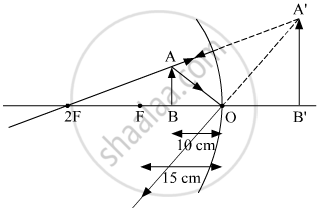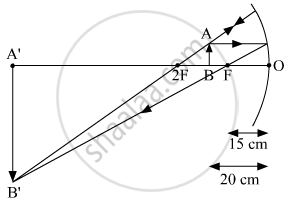Advertisements
Advertisements
Question
Suppose you have three concave mirrors A, B and C of focal lengths 10 cm, 15 cm and 20 cm. For each concave mirror you perform the experiment of image formation for three values of object distance of 10 cm, 20 cm and 30 cm. Giving reason answer the following:
(a) For the three object distances, identify the mirror/mirrors which will form an image of magnification – 1.
(b) Out of the three mirrors identify the mirror which would be preferred to be used for shaving purposes/makeup.
(c) For the mirror B draw ray diagram for image formation for object distances 10 cm and 20 cm.
Solution
(a) In case of concave mirror, a real and inverted image of same size is formed as that of object, when object is placed at a distance of 2F (R). Hence, in case of mirror A when object is placed at 20 cm , and in case of mirror B, when object is placed at 30 cm, the image formed will be of same size as that of object. Thus, magnification in both these cases will be −1.
(b) The mirror C, with focal length of 20 cm will be preferred to be used for shaving purposes/makeup. As within this focal length, enlarged and erect image will be formed.
(c)
(i) When the object is at 10 cm from the mirror
(ii) When the object is at 20 cm from the mirror
APPEARS IN
RELATED QUESTIONS
Draw a ray diagram to show the path of the refracted ray in each of the following cases:-
A ray of light incident on a concave lens is
(i) passing through its optical centre.
(ii) parallel to its principal axis.
(iii) directed towards its principal focus.
A student wants to project the image of a candle flame on a screen 48 cm in front of a mirror by keeping the flame at a distance of 12 cm from its pole.
(a) Suggest the type of mirror he should use.
(b) Find the linear magnification of the image produced.
(c) How far is the image from its object?
(d) Draw ray diagram to show the image formation in this case.
Write down a formula for the magnification produced by a concave mirror.
in terms of height of object and height of image
A student has focused the image of a candle flame on a white screen using a concave mirror. The situation is as given below:
Length of the flame = 1.5 cm
Distance of flame from the mirror = 18 cm
If the flame is perpendicular to the principal axis of the mirror, then calculate the following:
- Distance of the image from the mirror
- Length of the image
If the distance between the mirror and the flame is reduced to 10 cm, then what would be observed on the screen? Draw ray diagram to justify your answer for this situation.
A student has to determine the focal length of a concave mirror by obtaining the image of a distant object on a screen. For getting best result he should focus
(A) a distant tree or an electric pole
(B) a well-illuminated distant building
(C) well-lit grills of the nearest window
(D) a burning candle laced at the distant edge of the laboratory table
The mirror used by the ophthalmologist to examine the eye is _______.
Match the following.
| Convex mirror | Radio telescopes |
| Parobolic mirror | Rear – view mirror |
| Snell’s law | Kaleidoscope |
| Dispersion of light | sin i/sin r =μ |
| Refractive index | Rainbow |
Give any two applications of a concave and convex mirror.
Identify the device used as a spherical mirror or lens in following case, when the image formed is virtual and erect in case.
Object is placed between device and its focus, image formed is enlarged and behind it.
To obtain an image twice the size of the object, between which two points related to a concave mirror should an object be placed?
